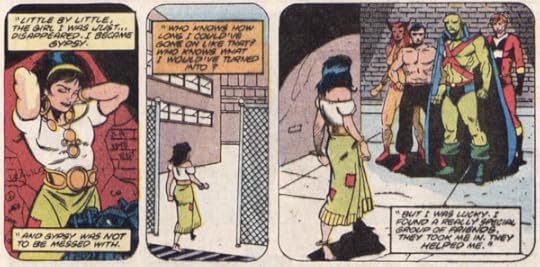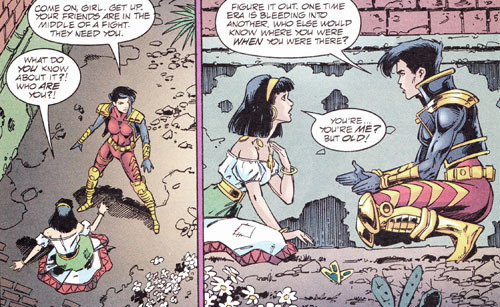Tansy Rayner Roberts's Blog, page 101
September 17, 2012
Glueing with Peanut Butter
 I have been working on my novel edits, honestly, even if they have brought along with them the most titanic attempts of procrastination than I have ever experienced before.
I have been working on my novel edits, honestly, even if they have brought along with them the most titanic attempts of procrastination than I have ever experienced before.
My favourite clanger that I caught in the manuscript yesterday is that if you’re going to use the metaphor that a character “glued himself” to his computer it probably shouldn’t be in the same sentence where he had just made himself a peanut butter sandwich. I just couldn’t stop staring at that sentence! It’s been there for YEARS.
My major achievement for the weekend, though, was something I have been fretting about for, well, years. When we moved into this house seven and a half years ago, with a brand new baby, we came from a compact 2 bedroom unit to a sprawling four bedroom house with lots and lots and LOTS of cupboard space. Naturally we exploded into the house like a cannon, filling every available corner with our (apparently compressed far too tightly) stuff.
The house was so big to us that we spent the first year or so of it living in only half, heating only half (turned out doing that saved no money btw) and sleeping with our baby in the master bedroom at the front of the house. The three bedrooms at the back were, well. Storage. Okay, a couple of studies and… anyway. We were especially cavalier with the built in cupboards because there were so many of them.
When we finally moved little Raeli into her own room at the age of two and a half (we malingered on the decision a bit because we didn’t want her at completely the other end of the house to us – took ages to realise we could move down there too, into one of the little rooms) we focused on the important things: a big girl bed, space for her toys, and so on. Kids have a lot of stuff, it’s true, but she was still tiny and certainly wasn’t going to be using hanging space any time soon.
The room was hers but the cupboards were basically still ours. As indeed were all the cupboards.
Later we got Jem and she went into her own little room a lot earlier, the whole family occupying the three back bedrooms while the big front one was transformed into my Library. Jem’s room was my former study, which means her cupboards are (still) packed to the rafters with all my crap including decades of notebooks stored in plastic crates and other paraphenalia. This was only a problem the time my Mum decided to prove to Jem there were no monsters in the cupboard and flung it open, only to traumatise our toddler with the sight a terrifying doll depicting Muppet Angelus.
Oops. I *was* storing monsters in her cupboard.
Anyway, Raeli is getting older, and needs bigger furniture, and has more clothes and so on, and it was starting to grate on me that she couldn’t use her own massive wardrobe, except for me to occasionally open the door and hurl something into it. In particular she wanted us to move her bunk bed so that instead of obscuring the window, she could look out of it.
I know, right? Fussy.
But the move meant about half as much wall space, and that meant that I needed to get her some furniture that was slightly taller than she was AND, well. The wardrobe. The enormous, four door built in wardrobe.
So last week, I bought furniture (as it turns out, three more pieces than I needed for this specific project, oops! Still, it’s all lovely and will be useful elsewhere in the house) and this weekend I rolled up my sleeves and took Raeli’s room apart and back together again.
When I was done, several podcasts and Big Finish plays and dust inhalations later, I had beautiful, organised wardrobes which are almost entirely devoted to Raeli and her many possessions. More to the point, there is room for more stuff – not a lot, but still. Instead of piling books on the floor or squeezing them into other parts of the house, she has extra shelf space for FUTURE BOOKS.
Not only that but this organisation has already improved other parts of the house – a small bookshelf we freed up is now tidily housing the children’s DVDs instead of them forming a fort around the television, and I have an entire massive shelf of one of my own bookcases (previously holding all the picture books too big to fit on Raeli’s titchy shelves) that I can fill with non fiction and/or graphic novels.
Also, um. If anyone wants a copy of Splashdance Silver I seem to have unearthed a whole extra box of them I didn’t know I had…
The moral of the story is: we have too much stuff. Our children have too much stuff. But crazy intense great-aunt-coming-to-visit levels of cleaning and organisation can reap great rewards.
Next thing you know, I’ll be looking closely at our wardrobe, and the fact that we never ever use it for anything except storing Christmas presents in. What the hell is in there? I have no idea.
Quick, someone buy another book off me and I might make a start on finding out!
September 16, 2012
Where the Wonder Women Are: #22 Gypsy
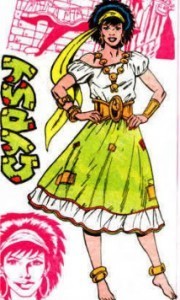 Like Vixen, Gypsy was one of the teen survivors of “Justice League Detroit”, the super team so 80’s it hurt. Like many characters representing cultures other than white American in superhero comics, her concept is… problematic rather than feeling truly representative of diversity.
Like Vixen, Gypsy was one of the teen survivors of “Justice League Detroit”, the super team so 80’s it hurt. Like many characters representing cultures other than white American in superhero comics, her concept is… problematic rather than feeling truly representative of diversity.
The odd thing is that as written, despite her wild black hair and “gypsy girl” costume, Gypsy doesn’t actually have much to do with Romany culture. While her origin claims she is of Romany descent, her family appear on the surface to be quite ordinary suburban Americans who don’t themselves identify with the culture she used for her superhero identity. It’s basically an excuse for the costume, and little else. (Having said that, after her mid-90′s recostuming she was briefly drawn with a reddish colour of skin, not sure if that was supposed to signify anything or if it was just an artist’s interpretation)
Cynthia “Cindy” Reynolds ran away to Detroit at the age of 14 when her powers of illusion (including invisibility and chameleon-like tendencies) began to develop, and apparently thought that dressing like an old timey carnival girl (including hoop earrings and serious gold bling) was the thing to do on the streets.
It worked for her, in any case, and when Aquaman threw his famous hissy fit leading to the new “no superheroes with their own book allowed” Justice League Detroit, the new team moved into Gypsy’s neighbourhood. She used her powers to sneak in to their covert headquarters (ha!) and was eventually cheeky enough to help them fight off their enemies, earning herself a place in the League.
When Justice League Detroit (and with it the “Justice League of America” title itself) folded after the deaths of Gypsy’s teammates Vibe and Steel, Gypsy/Cindy returned to her family and disappeared from the narrative for some years. J’onn J’onnz, the Martian Manhunter who had been their leader and father figure, continued into the new title, Justice League International.
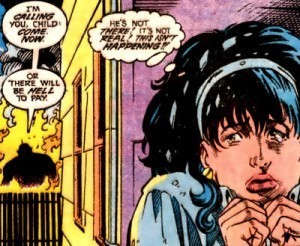 Despero, a recurring Justice League villain who was the alien embodiment of hatred, later returned to wreak revenge upon the Justice League who had bested him – and having not received the memo about the new team, he went directly for Gypsy, now living out a normal schoolgirl life though still, oddly, dressing like a carnival performer. He killed her parents and brother, sending her on the run so that he could locate the other members of the Justice League, and a violent and bloody battle ensued. J’onn put an end to the rampage by bestowing a unique Martian “gift” upon the alien warrior, giving him the illusion that he had destroyed them all and could disappear into a blissful eternal peace.
Despero, a recurring Justice League villain who was the alien embodiment of hatred, later returned to wreak revenge upon the Justice League who had bested him – and having not received the memo about the new team, he went directly for Gypsy, now living out a normal schoolgirl life though still, oddly, dressing like a carnival performer. He killed her parents and brother, sending her on the run so that he could locate the other members of the Justice League, and a violent and bloody battle ensued. J’onn put an end to the rampage by bestowing a unique Martian “gift” upon the alien warrior, giving him the illusion that he had destroyed them all and could disappear into a blissful eternal peace.
Quite rightly, the question was asked: why didn’t you do that BEFORE, and J’onn replied that it could only be used once in a lifetime.
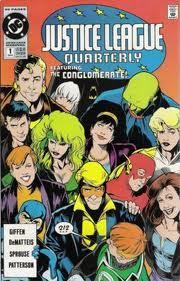 Gypsy was left miserable and homeless, but a new start was offered to her by Booster Gold, a brash hero from the future who had become frustrated with the lack of benefits afforded to superheroes, and was putting together a financially viable team, the Conglomerate. This led to all kinds of interesting stories around corporate sponsorship, compromises and “selling out.” While these stories, told through the pages of Justice League International and Justice League Quarterly, were mostly set up to see the effect it had on the fractured friendship of Blue Beetle and Booster Gold, as well as the rivalry between Conglomerate head Claire and her ex-husband, the Justice League’s manager Max Lord, Gypsy also got to explore some of the issues, and as an orphan it’s not surprising that she needed to combine super-heroics with some practicalities.
Gypsy was left miserable and homeless, but a new start was offered to her by Booster Gold, a brash hero from the future who had become frustrated with the lack of benefits afforded to superheroes, and was putting together a financially viable team, the Conglomerate. This led to all kinds of interesting stories around corporate sponsorship, compromises and “selling out.” While these stories, told through the pages of Justice League International and Justice League Quarterly, were mostly set up to see the effect it had on the fractured friendship of Blue Beetle and Booster Gold, as well as the rivalry between Conglomerate head Claire and her ex-husband, the Justice League’s manager Max Lord, Gypsy also got to explore some of the issues, and as an orphan it’s not surprising that she needed to combine super-heroics with some practicalities.
Other characters in the Conglomerate included Praxis, Maxi-Man, Echo, Vapor and even Vibe’s brother Reverb (yes, REALLY) and this team had such an astonishingly 90’s look that they came close to putting Justice League Detroit to shame in the “most rapidly dated super team” competition. Ultimately the team collapsed due to the pressures brought upon them by their corporate sponsors, the rebellious nature of the superheroes themselves, and their growing suspicion that they were participating in something morally dubious.
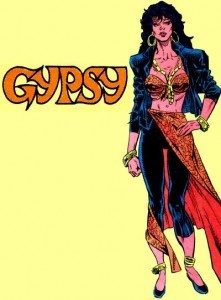 Gypsy found another home for herself in a later Justice League title, Task Force, alongside her old mentor J’onn J’onzz. This was initially a team up book where J’onn and Gypsy would assemble a new team every issue or two, to match a particular mission. This had the benefit of combining quite a few lesser used characters from Justice League’s past, and even reunited Gypsy with Vixen in my personal favourite story from this run, the one where they needed all women for a rescue mission to the jungle, and J’onn showed that his shape changing abilities could apply quite easily to gender.
Gypsy found another home for herself in a later Justice League title, Task Force, alongside her old mentor J’onn J’onzz. This was initially a team up book where J’onn and Gypsy would assemble a new team every issue or two, to match a particular mission. This had the benefit of combining quite a few lesser used characters from Justice League’s past, and even reunited Gypsy with Vixen in my personal favourite story from this run, the one where they needed all women for a rescue mission to the jungle, and J’onn showed that his shape changing abilities could apply quite easily to gender.
I liked J’oan J’onnz! I’d have kept her.
It’s nice that the partnership/father-daughter relationship between J’onn and Gypsy was allowed to continue, with him providing some of the stability that she had lost when Despero destroyed her family. During her time in the Task Force, Gypsy changed her previous look twice, first for a more glammed up version of her hoop earringed ‘gypsy’ costume (no more patched skirt) and later for red battle armour (matching the rest of the team) and a short haircut.
The relationship between J’onn and Gypsy was further developed after the Zero Hour event which partially rebooted the universe, and was the beginning of a DC tradition of ‘zero’ issues which provide new starting points for readers. Task Force was part of a massive, multi-title crossover involving the Overmaster and his Cadre leading up to Zero Hour, and it was actually in that title that the heroine Ice of Justice League America was killed. In the same story, Gypsy was left for dead in the snow, and later quit because of this, feeling betrayed by J’onn who had gone ahead with the rest of the team to fight the battle rather than staying to look for her.
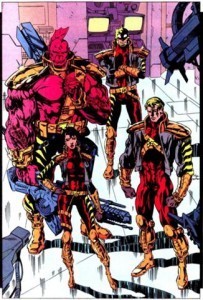 After the Zero Hour event and the various shifting of realities that occurred, the Justice League Task Force was developed as a teaching team made up of various young or inexperienced team-members – in many ways, similar to the original Detroit concept, especially with the Martian Manhunter as the mentor figure. Along with a returning, Gypsy and the Ray, JLTF provided home for Triumph, one of the most irritating results of Zero Hour. The concept for his character was that he was a founding member of the original Justice League – in fact, the leader and creator of the group – who had been caught in a reality rift on his very first adventure, and been promptly forgotten by the universe, until now.
After the Zero Hour event and the various shifting of realities that occurred, the Justice League Task Force was developed as a teaching team made up of various young or inexperienced team-members – in many ways, similar to the original Detroit concept, especially with the Martian Manhunter as the mentor figure. Along with a returning, Gypsy and the Ray, JLTF provided home for Triumph, one of the most irritating results of Zero Hour. The concept for his character was that he was a founding member of the original Justice League – in fact, the leader and creator of the group – who had been caught in a reality rift on his very first adventure, and been promptly forgotten by the universe, until now.
It was a stupid idea. Never mind that the original Justice League was made up of characters who were all adults and experienced superheroes, but Triumph was young, entitled and bratty. I can’t imagine 1960’s Batman or 1980’s Batman taking any crap from him. His role in JLTF was mostly to sulk that he didn’t get the respect of the Big League Heroes despite being their ‘peer.’ Shut up, Triumph, no one believes in you.
Triumph’s creators decided that since DC fans universally loathed this character, it would be fun if all his teammates hated him too. Imagine how fun that was.
But Gypsy’s main stress in this group came from a different team member. Despero hadn’t stayed in the ‘happy place’ created for him by J’onn and had returned several times to destroy the League. At the culmination of the Breakdowns saga, they had finally conquered him by swapping his brain with that of L-Ron, Maxwell Lord’s comedy robot sidekick. Trapped in the body of a tiny and ineffectual robot, Despero had finally been wiped out by a random duck shooter.
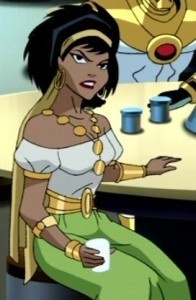 Meanwhile, the comedy robot had a big pink alien warrior body to play with, and now he was back in town. Gypsy had to cope with the fact that one of her teammates and allies wore the body of the creature who had murdered her family and terrorised her. While this was an interesting character point for her to explore, it has to be said that the writing of this particular arc seemed to ignore all previous characterisation of L-Ron, so that his voice didn’t feel at all like the character that those of us who had read Justice League International actually knew.
Meanwhile, the comedy robot had a big pink alien warrior body to play with, and now he was back in town. Gypsy had to cope with the fact that one of her teammates and allies wore the body of the creature who had murdered her family and terrorised her. While this was an interesting character point for her to explore, it has to be said that the writing of this particular arc seemed to ignore all previous characterisation of L-Ron, so that his voice didn’t feel at all like the character that those of us who had read Justice League International actually knew.
Justice League Task Force was cancelled (with Triumph being accidentally pulled out of history again), but Gypsy and J’onn remained close and she made (very) occasional appearances in the Justice League or associated titles (such as Birds of Prey), back in her old and far more recognisable costume. Several of these appearances were in support of her former teammate Vixen. She also appears often in the background of the animated series Justice League Unlimited, though I don’t believe she was ever given a speaking role. She has, however, appeared in at least one issue of the associated comic.
In JLA: Incarnations, Justice League Detroit had one last ride in a story that involved the future Gypsy from Task Force travelling back to help her younger self save the day.
As of the New 52 reboot, there is no word as to whether Gypsy exists in this universe, but the Martian Manhunter’s history with the Justice League has been entirely erased so as to include him in the secret society Stormwatch. This basically means that almost nothing of Gypsy’s history can have existed up to the present day, though there is nothing to stop them bringing the character back in the future except, perhaps, that she has no particular fan following which probably means she is way back in the queue until someone comes into power at DC who has squishy nostalgic feels about the 1980′s and Justice League Detroit. Hey, it could happen!
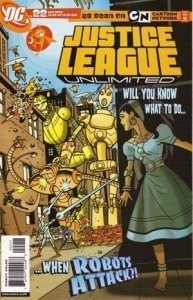 Gypsy is one of those characters who could easily be written off as weak or passive, and she has had several times in her life where she doubted her own usefulness as a superhero, or had her powers criticised by other characters. However, as with many of the “lesser powered” superhero characters, it comes down to the cleverness and ingenuity of writers. She can not only turn invisible and camouflage herself, but also cast illusions which makes her an excellent stealth operative. On the other hand those powers alone are rarely going to cut it, which is why she works at her best in a team.
Gypsy is one of those characters who could easily be written off as weak or passive, and she has had several times in her life where she doubted her own usefulness as a superhero, or had her powers criticised by other characters. However, as with many of the “lesser powered” superhero characters, it comes down to the cleverness and ingenuity of writers. She can not only turn invisible and camouflage herself, but also cast illusions which makes her an excellent stealth operative. On the other hand those powers alone are rarely going to cut it, which is why she works at her best in a team.
My favourite Gypsy era, apart from the early Task Forces, was actually her time in the Conglomerate, explored in the most depth in Justice League Quarterly #1, as it felt like this story really explored what it meant for those characters, all considered “minor” to be superheroes, and how it would affect daily life to have that as a job. I doubt Gypsy would ever have the name recognition or the oomph to headline her own title, but I’d love to see her as part of a team with multiple female characters, with a writer who appreciates the usefulness of her skills.
As long as that team doesn’t include Triumph, or Despero. Is that too much to ask?
Where the Wonder Women Are:
0: Introduction
1: Black Canary
2: Rogue
3: Hawkgirl/Hawkwoman
4: Black Widow
5: Wonder Girl
6: Captain Marvel
7: Vixen
8: Abigail Brand.
9. Jubilee
10. Batwoman
11. Catwoman
12. Huntress
13. Robin
14. Batgirl
15. Jean Grey
16. Ice
17. Emma Frost
18. Fire
19. Lady Sif
20. Supergirl
21. The Wasp
September 14, 2012
Babies and Bicycles: watching Call the Midwife
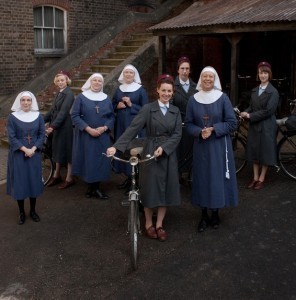 The first hint I had that “Call the Midwife,” a British TV series set in the post-War East End of London, was A Thing was when I saw all the tie-in books sprawled across the front page of Fishpond.com. Then I heard that the lead actress was being tapped for a Doctor Who episode. So it must be successful!
The first hint I had that “Call the Midwife,” a British TV series set in the post-War East End of London, was A Thing was when I saw all the tie-in books sprawled across the front page of Fishpond.com. Then I heard that the lead actress was being tapped for a Doctor Who episode. So it must be successful!
But the most watched BBC One drama in 10 years? Wow. Just, wow.
The main reason this is so WOW is because this is a story about women. More to the point, it’s a story about women and pregnancies and labor and children and that whole maternal merry-go-round, including the messy parts. Also, nuns on bicycles.
And it’s fascinating!
The story revolves around a small group of nurses and nuns who live in a small convent house and cover an 8 mile area of the roughest part of London in the 1950′s. The dominant narrative for most women in that area is having babies, lots of babies, and it’s the job of the midwives to provide the majority of the healthcare for those women, including clinic check ups and home deliveries.
There are doctors around, and occasional mention of the fact that the newly formed NHS provides services never before heard of such as a flying squad, ambulances and even occasional neo-natal care, but the majority of the births are in the hands of the local midwives.
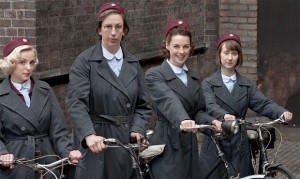 I’m loving the show because it’s drama about the work of women, and while I’m sure there are a couple of romantic threads to be played out in this season (I’ve watched 2 of the 6 episodes, the first one is about to vanish from ABC’s iView) the lack of focus on romance narrative is so refreshing. Instead the first two episodes tells the story of two new midwives coming from privileged backgrounds joining the team and struggling with a massively steep learning curve. We have class issues, skills issues, the actual drama of the work itself including the relationships they form with their patients, and that’s plenty to be getting on with.
I’m loving the show because it’s drama about the work of women, and while I’m sure there are a couple of romantic threads to be played out in this season (I’ve watched 2 of the 6 episodes, the first one is about to vanish from ABC’s iView) the lack of focus on romance narrative is so refreshing. Instead the first two episodes tells the story of two new midwives coming from privileged backgrounds joining the team and struggling with a massively steep learning curve. We have class issues, skills issues, the actual drama of the work itself including the relationships they form with their patients, and that’s plenty to be getting on with.
As someone who is currently living motherhood as a dominant narrative, I am also loving the way that children are factored into the story as a constant presence – because of course they have to be. They’re not there as cute quippers, but they fill the streets and the stories and the scenes because these women have so many to juggle. The first episode looked at a family where the mother was an Italian migrant who spoke no English and had borne twenty four healthy children to her husband – and while they lived in squalor that was hard for our newbie nurse Jenny to take in at first, they were happy. But the drama comes with the twenty fifth baby…
Considering how much hard work it must have been to produce the show and manage all those children (including some very new babies) I am impressed at the authenticity and the realism depicted on screen, and the matter or fact truth of these women’s daily lives. Considering that the scripts are themselves based on the memoirs of the real Jenny, midwife Jennifer Worth, I think that the production values and attitude of the show is amazing.
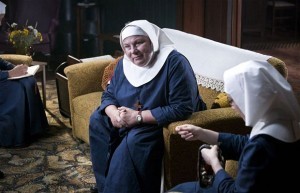 Also, the characters, oh. How many different kinds of female characters can you include when almost all the major speaking roles are women? We have nuns and nurses of all ages, shapes and sizes, not to mention from a variety of backgrounds, even before we get to the women of themselves and the community of mothers, wives and working women from the area. Any TV show that provides meaty roles for Pam Ferris, Jenny Agutter and Miranda Hart is doing something worthwhile to me.
Also, the characters, oh. How many different kinds of female characters can you include when almost all the major speaking roles are women? We have nuns and nurses of all ages, shapes and sizes, not to mention from a variety of backgrounds, even before we get to the women of themselves and the community of mothers, wives and working women from the area. Any TV show that provides meaty roles for Pam Ferris, Jenny Agutter and Miranda Hart is doing something worthwhile to me.
Did I mention it’s also funny? The women are warm and enthusiastic and snarky, and there are plenty of moments of humour along with the emotional highs and lows – some of it quite earthy, as you might expect. The second episode, revolving around the arrival of Chummy, a highly aristocratic and barely-qualified but Good Sort nurse played by Miranda Hart shows her struggles to keep up with everyone, and that while she doesn’t bat an eyelid about the horrible conditions etc. as Jenny did in the first episode, her problems are more mundane, such as clumsiness and particularly her lack of bicycle skills, but nearly every line out of her mouth is comedy gold.
The bicycle is an essential icon of the series, with the nurses all flying every which way on wheels to get to their charges and appointments, often through streets that are thick with people and/or deep fog. They represent very much the independence and hard work of the midwives, and Chummy’s inability to ride a bike was a beautiful if quite sad at times example of how out of place she was among them, and how she was going to have to work so much harder to be a useful member of the team. Learning to ride a bike is HARD, yo!
It’s not for the faint-hearted, with some hardcore obstetrics on show, a lot of blood and gore in the bedrooms, and emotional highs and lows – as someone with a serious issue with the depiction of dead/lost babies in stories, I didn’t think I’d make it through, but the first two episodes were either done with great subtlety or were going easy on me. I suspect the latter, as this is intended to be an uplifting show for all its focus on the scary side of human biology. And so far there has been a notable restraint in the dead baby stories. Though I’m eyeing episode three with suspicion, I think that was the first one that House threw at me…
My love for social history is definitely outweighing my squeamishness, and I am loving seeing a side to women and their history that I knew little about. Call the Midwife is sentimental and squishy but balances this out with a bunch of tough love and stoic grit that for me at least cuts through the mush. (though I always cry when the baby is properly born safely, I admit it)
I’m also fascinated by the depictions of social detail of the time, the way that the men are kept in such ignorance about childbirth and associated matters, actively excluded from so much to do with their wives’ lives, and the way that so many mothers form communities together to survive the needs of childcare. The multi-generational families, where women might be giving birth while their daughter celebrates her wedding, and the children have to cook and clean for their siblings. The family eating out of a communal pot because when you have twenty four kids, why would they all get plates? The constant smoking, dear gods, the SMOKING, Mad Men is nothing on this, where we see pregnant women lighting up in the hospital clinic, doctors smoking around their patients, and nurses smoking over the dinner table.
I definitely think that anyone who writes childbirth scenes in say, fantasy fiction or anything with a historical background could benefit from watching this, because while they have quite a few advantages in the 1950′s that weren’t around in earlier centuries, there’s still a whole lot of old school midwifery on show.
And it would be nice if more fantasy writers took on board the idea that you can have a dramatic childbirth scene in a narrative even if (especially if) both the mother and child survive.
September 13, 2012
Reasons to Love Pinterest #1 – Dalek Bedtime Stories
Friday Links Meets House
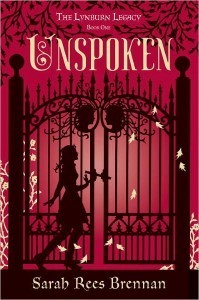 I’m excited that the new Sarah Rees Brennan novel was released this week – her gothic girl-detective-meets-house YA Unspoken, and as far as I know (Schroedinger’s PO Box, anyone?) I might already have my copy!
I’m excited that the new Sarah Rees Brennan novel was released this week – her gothic girl-detective-meets-house YA Unspoken, and as far as I know (Schroedinger’s PO Box, anyone?) I might already have my copy!
Sarah has wound up her two series of blog essays, Gothic Tuesday and Sleuth Thursday (sob! I’ll miss them!) with a parody of Northanger Abbey. Yes, she parodies the parody. She has no shame!
Sarah also talks about the central concept of her novel over at John Scalzi’s The Big Idea. But enough pluggery, let’s get some linkitude under our belts.
This one’s for my friends on Twitter discussing the ‘maternal driveby’ and how many people (often complete strangers) like to get in the face of a pregnant or new mother: a hilarious article at McSweeney’s of all places entitled “Hello Stranger On the Street, Could You Please Tell Me How to Take Care of My Baby?”
A reader of my Supergirl post this week passed on a link that made me sad but hopeful, in which the creators of the awesome and girl-friendly comics “Supergirl’s Cosmic Adventures in the Eighth Grade” plotted out the later adventures of their Kara for the ninth grade and beyond, and have sketches to prove it. The sad thing is that this comic doesn’t exist but the hopeful thing is that it doesn’t definitely not EVER exist yet.
Nicola Griffith talks about the new Kindle Paperwhite which looks amazing and points out in particular some of the features that might appeal to writers.
Bitch Magazine talks about what Rhianna and Agatha Christie have in common, and reclaims them both to the side of feminism. I think.
Sleeps With Monsters addresses the idea of male writers who “get it right” when it comes to writing interesting, complex female characters, and discusses a few of her favourites. Me, I still have that GRRM quote running around in my head this week: “You know, I’ve always considered women to be people.”
Speaking of writing women as if they are people, the legendary Greg Rucka was interviewed on the 3 Chicks Review Comics podcast, and he talked at great length about his work, the amazing characters he has got to handle, why Wonder Woman is his favourite, and what’s wrong with the comics industry as a whole as regards diversity etc. Really compelling stuff, and that’s before the revelation about the comic that never was: a Greg Rucka Wonder Woman Year One drawn by J.H. Willams. He also talks about his ‘creator-owned’ work and the recently released new series of Stumptown, and lots of behind the scenes comics stuff. Well recommended.
[SPOILERS FOR CURRENT SEASON OF DOCTOR WHO IN THIS LAST LINK, DAVID THIS MEANS YOU]
[Calapine has written an adorable piece of fanfic exploring what might happen if a certain Doctor had not left a certain Dalek to die horribly in an exploding planet, and instead taken her on board as his companion. Did I mention adorable?]
Now for the last (so far?) of the Super Best Friends Forever shorts – I’ve been hunting this one online for ages! Disappointed there wasn’t as much of this series as I was hoping for, as it appeals instantly to all the kids in my life, many of whom are boys – SBFF might be aimed at girls but it’s active and funny and I’ve often watched the clips surrounded by laughing boys between the ages of 4 and 9. Get it together, DC Shorts! You’ve got a winner on your hands here, and in these My Little Pony days, a full length series of SBFF could well take off into the stratosphere.
Speaking of adorable…
September 12, 2012
GUEST POST: Morgan Keyes and the rituals of Darkbeast
Something a bit different today! I’d like to introduce Morgan Keyes, author of new children’s novel Darkbeast. Morgan has also written for adults under the name Mindy Klasky, and I loved her urban witch romances, so I’m excited to see her turn her hands to children’s fantasy. Given my interest in rites and festivals stemming from the Creature Court trilogy, I asked Morgan to talk about the role of rituals in her book. TRR xxx
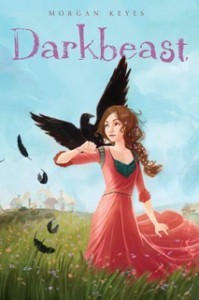 Many thanks to Tansy, for allowing me to visit and tell you about my middle grade fantasy novel. In Darkbeast, twelve-year-old Keara runs away from home rather than sacrifice Caw, the raven darkbeast that she has been magically bound to all her life. Pursued by Inquisitors who would punish her for heresy, Keara joins a performing troupe of Travelers and tries to find a safe haven for herself and her companion.
Many thanks to Tansy, for allowing me to visit and tell you about my middle grade fantasy novel. In Darkbeast, twelve-year-old Keara runs away from home rather than sacrifice Caw, the raven darkbeast that she has been magically bound to all her life. Pursued by Inquisitors who would punish her for heresy, Keara joins a performing troupe of Travelers and tries to find a safe haven for herself and her companion.
When I was twelve years old like Keara, I adored Katherine Kurtz’s Deryni series. While I liked the characters and the medieval setting, I loved the rituals embedded in the story. Kurtz’s magical Deryni raised their power through complicated spells, invoking archangels and natural forces, binding together the physical world and the arcane.
At that age, I was primed to embrace ritual. As a twelve-year-old girl, I was preparing for my bat mitzvah, for the ceremony that would allow me to be recognized as an adult in my religious community. I was fascinated by the ritual prayers recited when the sacred scrolls were taken from the ark. I was enchanted by the tradition of gathering in the light from newly kindled candles, by cupping the brightness and bringing it to rest against my eyes.
That feeling of magic, that sense of power, never faded. As I wrote my fantasy novels I tried to capture the numinous, to make it real for my readers.
Keara’s life is layered in rites and rituals. She follows the Family Rule in her home village, relying on traditional formulas to greet relatives and to take her leave. On her nameday, when she is expected to offer up her darkbeast sacrifice, Keara is clothed in a specially embroidered gown. Her face is painted with strange, new-to-her cosmetics. She is escorted through the streets by children who cant traditional rhymes.
The actual ceremony takes place in a godhouse, a temple dedicated to the god of darkbeasts. Keara follows the expected formulas as she greets the priest, as she enters the inner sanctum, as she surrenders to the darkness of a room lit only by a brazier.
Keara knows all the rules and expectations; the power of ritual is embedded deep within her. Therefore, when she breaks with those traditions, she understands the challenges that arise. She expects Inquisitors to seek her out, to punish her with the full extent of their religious might.
An ordinary child might be afraid to break the rules. A typical girl would hesitate to cast away everything she had always done, all the things she had ever believed.
But Keara is no ordinary young woman. She has a strong sense of right and wrong, a conviction that mandates every one of her actions. And if she finds replacement rites and rituals along the way, who can blame her for building new traditions?
Because the Travelers, the itinerant acting troupe that Keara joins, have their own host of traditions. They have Holy Plays, where the words cannot be changed. They have symbolic costumes and props, specific references that automatically bring to bear the power of the gods and goddesses they worship. They have methods of traveling, of setting up camp, or breaking down their stage – intricate ways of making their theatrical life work.
Of course, a novel wouldn’t be interesting if everything just stayed the same. Readers can be pretty sure that Keara won’t follow every last one of the Travelers’ traditions in every expected way. That’s what makes Keara’s life a challenge. That’s what makes her story an adventure.
How about you? What rites and rituals are central to your daily life? (And yes. To me, drinking that first cup of morning tea counts!)
====
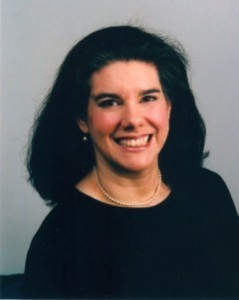 Morgan can be found online at:
Morgan can be found online at:
http://www.morgankeyes.com
http://www.facebook.com/morgan.keyes.author
Darkbeast is for sale in bricks-and-mortar and online bookstores, including: Amazon | B & N | Indiebound
Morgan Keyes grew up in California, Texas, Georgia, and Minnesota, accompanied by parents, a brother, a dog, and a cat. Also, there were books. Lots and lots of books. Morgan now lives near Washington, D.C. In between trips to the Natural History Museum and the National Gallery of Art, she reads, travels, reads, writes, reads, cooks, reads, wrestles with cats, and reads. Because there are still books. Lots and lots of books.
Chucking a Domestic in a Daisy-Filled Meadow
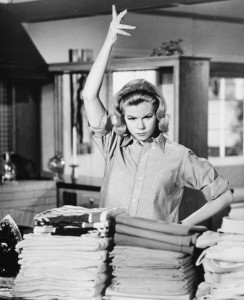 I think the domestic fever which usually hits me in November-December has arrived early. Either that or I have novel edits to go through and thus am doing the washing up three times a day and planning major room renovations.
I think the domestic fever which usually hits me in November-December has arrived early. Either that or I have novel edits to go through and thus am doing the washing up three times a day and planning major room renovations.
I HAVE PLANS TO CLEAN CUPBOARDS.
Oh, wait, novel edits. That does make sense.
The school holidays have started, and I was going to be so Zen about them this time. I have learned that the trick to school holidays is to a) not have too many high expectations of my capacity to do Idyllic Childhood Activities with my kids and b) not to have too many or indeed any expectations of my capacity to get any work done in that time because that way lies resentment and anguish.
I slipped up, on both counts.
Our winter term was so hectic with soccer and other activities that I started thinking blissfully of how nice it would be on holidays with no pick up times and gymnastics etc to worry about. And I saw my daughters not getting nearly enough playtime together and missing each other while they were off at separate schools/daycare etc. and thought, awww they’ll get lots of playtime in the holidays! Possibly in a daisy-filled meadow. So I will work against my usual thing and not over-schedule them at all so we can actually relax together, Mummy and daughters, without rushing off every day to Achieve Holiday.
Plus, you know, they occupy each other so well now that Jem is three, chances are very high that I will be able to get work done, tapping away on my computer during the day in a relaxed writing montage kind of way. I didn’t even blink when the edits for A Trifle Dead arrived (don’t panic, Alisa!) because that’s exactly the sort of work that’s easy to get done in a holiday, right? In fact, we were going to Devonport for a long weekend and I could probably knock the whole thing off then…
Heh. This is the trouble with being a writer. You do tend to fictionalise your future plans, with better dialogue and story outcomes than may be realistic. Or is that just me?
So I got 7 chapters done at Devonport, it was a start, but then we got home and had our first proper day of the holidays. And my beautiful girls were trying to kill each other by about 10am. Admittedly this was partly because a promised visit from Glammer hadn’t happened to to a damaged cat (he’s getting better now). Jem stomped for the first time, tried out her pout, and bashed Raeli in the eye. Raeli sulked and fretted about having to do things with her sister. The Apocalypse loomed.
Thankfully I had managed to schedule (HA!) in a sleepover that night, and as soon as Raeli’s little friend arrived to set up home in the top bunk and play with the girls, they became angels again. The three of them played beautifully, ate tea beautifully, and even slept without too much silliness and giggling. The next morning they played solidly, mostly outside (DAISY-FILLED MEADOW) and when they took a break from that, we baked cookies and had jolly times together.
I can’t complain too much, as the girls did allow me to take a very long business call that afternoon without their usual chorus of MUM, Muuuum, MUMMY, MuUuUm… but they did totally spend the whole afternoon watching/playing on various computer devices. I have no guilt. I’ve cooked a hot lunch for them every day this week, kept the kitchen clean, and I even spent some time playing computer games WITH Raeli. I’m doing okay here.
I think if there’s a lesson to this story (for me) it’s that scheduling stuff is not a bad thing. Over-scheduling bad, but those holidays where the days stretch out endlessly without plan and the meadows have daisies and the children can live entirely on banana passionfruits picked from the garden? I don’t think they just happen.
So next week, I think I’ll be making a few calls and getting a little more organised about hooking the girls up with friends, and doing actual things. And, you know. Getting my edits finished, too. But maybe saving the “fix that broken short story” and “get on top of my novel-in-progress” major tasks until after the holidays are done.
We have Lego to build, and cookies to bake, after all. And daisies.
September 11, 2012
Where the Wonder Women Are: #21 The Wasp
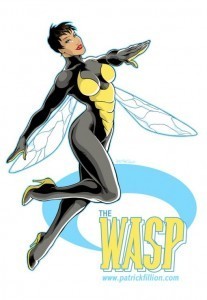 When Joss Whedon’s Avengers movie screened this year, it certainly felt feminist-ish (or at least not unfeminist) to many moviegoers. But it didn’t pass the Bechdel Test, which asks you to consider whether a movie includes 2 or more named female characters who talk to each other, and if not to at least question why that is the case – and Black Widow was also one of the two non-super-powered characters in the team, which would have been less jarring had she not been the only woman. While Black Widow was beautifully written and performed, and given a significant piece of the movie (she has the third most lines of all the characters, behind the two headline acts Captain America and Iron Man), most people who knew their Avengers comics could put a finger directly on which female Avenger was most obviously missing.
When Joss Whedon’s Avengers movie screened this year, it certainly felt feminist-ish (or at least not unfeminist) to many moviegoers. But it didn’t pass the Bechdel Test, which asks you to consider whether a movie includes 2 or more named female characters who talk to each other, and if not to at least question why that is the case – and Black Widow was also one of the two non-super-powered characters in the team, which would have been less jarring had she not been the only woman. While Black Widow was beautifully written and performed, and given a significant piece of the movie (she has the third most lines of all the characters, behind the two headline acts Captain America and Iron Man), most people who knew their Avengers comics could put a finger directly on which female Avenger was most obviously missing.
There were many women to choose from, actually, including Ms/Captain Marvel, She-Hulk, Spider-Woman, and Hellcat. But the Wasp, AKA Janet Van Dyne (later Pym) was the only woman to be a founding member of the Avengers in the comics. Leaving her out was a bit like doing a Justice League movie without Wonder Woman (or like rewriting the Justice League continuity so Wonder Woman wasn’t the first female founding member, cough). Well okay, maybe not that. Wasp isn’t quite as famous as Wonder Woman. But it was certainly like doing a Fantastic Four movie without Sue Storm, or a ‘first’ X-Men movie without Jean Grey.
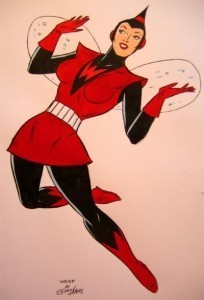 Joss Whedon himself was aware of the omission, and said in interviews that he tried desperately to keep the Wasp in the script all the way through, despite this not serving the story he was telling, and that there was basically an intervention by his friends in order to make him take her out. For now.
Joss Whedon himself was aware of the omission, and said in interviews that he tried desperately to keep the Wasp in the script all the way through, despite this not serving the story he was telling, and that there was basically an intervention by his friends in order to make him take her out. For now.
I’m not complaining about the Avengers movie. I think it was a brilliant launch of the team, and I can agree that there’s no obvious place where the Wasp could have been introduced. Dealing mostly with characters who had been established in previous films was one of its most successful creative choices, and really the only plot spot that could have been taken by an extra female Avenger was that of Hawkeye – and I’m fond enough of Jeremy Renner’s performance to not quibble about that. The Wasp is an interesting character who probably does need to be more substantially set up before being brought in to the Avengers crowd.
What intrigues me most is *which* Janet Joss Whedon kept adding to his script. Because there’s two clearly distinct versions, and now that the Ant-Man (Wasp’s husband) film has been given the green light, it’s not going to be Joss who picks which Wasp belongs to the Marvel film universe. It’s going to be “Scott Pilgrim” (and Spaced)’s Edgar Wright.
Assuming of course that they are going to include Janet in the Ant-Man movie. And I tell you, heads are gonna ROLL if they don’t.
 I started out with the Ultimates Wasp (The Ultimates being the equivalent of the Avengers in the Marvel Ultimate Universe, a separate continuity established in the last decade or so), which means that when I think of Janet Pym, I think of an intelligent Asian American scientist who is more important to the Avengers than her loose cannon husband (also a scientist but a less good one). Yes, her superpowers are basically the ability to shrink down and fly around, but Janet’s knowledge of physics and human biology means she uses this to great effect, often disabling her foes by whopping them in the inner ear.
I started out with the Ultimates Wasp (The Ultimates being the equivalent of the Avengers in the Marvel Ultimate Universe, a separate continuity established in the last decade or so), which means that when I think of Janet Pym, I think of an intelligent Asian American scientist who is more important to the Avengers than her loose cannon husband (also a scientist but a less good one). Yes, her superpowers are basically the ability to shrink down and fly around, but Janet’s knowledge of physics and human biology means she uses this to great effect, often disabling her foes by whopping them in the inner ear.
She’s also a troubled, angry woman, whose marriage is unbalanced by her husband Hank’s jealous rages, and who finally leaves him after a fight between them turns ugly and abusively violent. Janet’s next relationship, with the hot-but-anachronistic Captain America, leaves her frustrated as she discovers that for all his sexy gentlemanly ways, he’s a man of the 1940’s in all sorts of ways, and she’s basically dating a geriatric.
I was drawn to Janet as a character, and not just because she was the only woman in the book that wasn’t evil. She was smart, snarky and competent, didn’t suffer fools, and I appreciated the fact that the domestic violence story was taken seriously and that her teammates supported her over Hank, who was also their teammate.
Janet was a strong character despite everything she went through. I was intrigued to find out more about her, and did some research, which led me to the stunning revelation that the Wasp of the standard Marvel Universe was an entirely different personality.
 The original Wasp, Janet Van Dyne, may have been the first female Avenger, but as with many 60’s and 70’s super teams (especially in the Marvel universe, I have to say) she was very much the token female, and her character was most often used as comic relief.
The original Wasp, Janet Van Dyne, may have been the first female Avenger, but as with many 60’s and 70’s super teams (especially in the Marvel universe, I have to say) she was very much the token female, and her character was most often used as comic relief.
Her powers were under-utilised and her costume was silly even by the standards of the day, leading many fans to dismiss her as “lame” (something I heard a lot when the Avengers movie came out from those arguing why she was best not included). She was a super girly girl and her feminine qualities were, well, Of Their Time.
A bubbly heiress and fashionista who eventually founded her own fashion design company, Janet was a rich redhead with a love of shopping. Her romance/relationship with Hank was usually there for comic relief in the early days, with him regularly commenting on what a nut she was for caring so much how she looked, what she wore, and to some extent how everyone else looked and what they wore.
She was fun and adorable, which means that the later storyline in which her husband hit her (while going through a mentally unstable phase) was probably a whole lot more shocking. She was also a good and generous friend, and many of the bits I have seen of the early Marvel Wasp (and indeed the all-ages Marvel Adventures comic now) show her interacting with the many women that later joined the team. It’s also quite refreshing that she didn’t become a superhero (as so many more modern women do) because of some dreadful trauma or angst or tragedy in her past, nor were her Wasp powers something imposed upon her by accident or someone else’s design. She chose to take on those powers, in order to help people. She also wasn’t ‘just’ a girlfriend/wife character, and was at times a member of the Avengers when her husband was not.
Oh but she’s dead now. So there’s that. Though rumour has it that the Wasp may be making a return to the Marvel universe with the Marvel Now not-reboot starting later this year.
So, sweetie pie redhead fashion designer or snarkangsty Asian-American scientist? Which one are we going to get?
I have to say that there is going to be some serious disappointment if Janet is cast as a Caucasian actress. The Marvel filmverse has taken many cues from the Ultimate universe, which tends to reflect more modern sensibilities when it comes to female roles and racial diversity. Notably this led to the casting of Samuel L Jackson as Nick Fury, and there’s no denying how amazing he is in the role. (Having started on my Marvel reading journey with the Ultimate universe, I personally struggle with reading comics where Nick Fury is a white man, it makes no visual sense to me)
But there’s no reason that whomever is writing the script for Edgar Wright (is it Simon Pegg? Please say it is) can’t still choose to make Janet a more old school depiction of the character, which would please many fans. If she’s introduced in the Ant-Man movie and not the Avengers movies, her original backstory might be a touch more credible than if a fashionista suddenly arrived on the helicarrier, and it’s not like the superheroes of that world couldn’t do with some serious fashion advice.
 I do, however, have a soft spot for scientist Janet (she was my first) and I very much like the way that the more positive aspects of her Ultimates persona were reflected in the Marvel Ultimate Avengers animated movie. With the “adult themes” carefully pared away, we still had a gutsy and interesting character who was a more useful member of the team than her erratic husband, and whose powers were used with intelligence and creativity. Janet doesn’t have to be an anachronistic dolly bird, but she also doesn’t have to be a hardboiled domestic abuse survivor. I’d settle for ‘woman who is good at her job.’
I do, however, have a soft spot for scientist Janet (she was my first) and I very much like the way that the more positive aspects of her Ultimates persona were reflected in the Marvel Ultimate Avengers animated movie. With the “adult themes” carefully pared away, we still had a gutsy and interesting character who was a more useful member of the team than her erratic husband, and whose powers were used with intelligence and creativity. Janet doesn’t have to be an anachronistic dolly bird, but she also doesn’t have to be a hardboiled domestic abuse survivor. I’d settle for ‘woman who is good at her job.’
There’s a tendency among older superhero comic fans to assume that gritty is cool, and women depicting traditionally masculine traits (while looking sexy) are the best, strongest female characters. Part of me is quite curious to see the fluffy, frivolous, quirkyfemme Janet of the original Marvel universe thrown among the Avengers pigeons because come on, don’t you want to see her trying to redesign Black Widow’s outfit? Don’t you want her to ask Thor how he gets his hair like that? But Janet could do all that and STILL use her powers really intelligently, and STILL be depicted by an non-Caucasian actress.
 I’m a bit excited and worried about what Edgar Wright is going to give us, Waspwise, in the Ant-Man movie. Because whatever he chooses is what Joss Whedon is going to have to work with.
I’m a bit excited and worried about what Edgar Wright is going to give us, Waspwise, in the Ant-Man movie. Because whatever he chooses is what Joss Whedon is going to have to work with.
One thing’s for sure, I REALLY want to see the Wasp in The Avengers II. Whichever Wasp she is.
Where the Wonder Women Are:
0: Introduction
1: Black Canary
2: Rogue
3: Hawkgirl/Hawkwoman
4: Black Widow
5: Wonder Girl
6: Captain Marvel
7: Vixen
8: Abigail Brand.
9. Jubilee
10. Batwoman
11. Catwoman
12. Huntress
13. Robin
14. Batgirl
15. Jean Grey
16. Ice
17. Emma Frost
18. Fire
19. Lady Sif
20. Supergirl
Watching New Who: Voyage of the Damned
 “VOYAGE OF THE DAMNED”
“VOYAGE OF THE DAMNED”
Christmas Special 2007.
The Doctor – David Tennant
Astrid Peth – Kylie Minogue
TANSY:
Before we get started, can I just ask – have you both watched “Time Crash,” the Children in Need special which takes place between the farewell of Martha and the collision of the TARDIS with the Titanic?
TEHANI:
I have! But I went and watched it again to remember. So cute seeing Tennant fanboy over Peter Davison (er Moffett – that’s not confusing at ALL).
DAVID:
I hadn’t, but I have now! I wish I had watched it first, because it makes the start of “Voyage of the Damned” a little more understandable. I know it is one of those things that if you aren’t a fan would make very little sense at all and would seem very self indulgent, but I LOVED it. My strongest memories of Doctor Who are Baker and then Davison and it brought back a lot of memories.
I really enjoyed the little jokes about aging and the obviously heartfelt bit at the end, and Tennant was clearly thrilled and a little awed to be working with Davison. It’s great to know that he is a fan at heart too, and so are the writers. I’ve really appreciated that New Who hasn’t just thrown out or tried to disown Classic Who and this is a great example of how most of the people in the new show wanted to be involved because they loved the old show.
On to Voyage! For me, this is probably the strongest of the Christmas specials so far. I have to admit, for a moment I was thinking that is was actually set on the real Titanic, and then I started to notice all the odd little features of the setting and twigged. In my defense, I was distracted when I caught of a glimpse of someone and thought, “OMG, is that Kylie?!”
TANSY:
I’ve had mixed feelings about “Voyage of the Damned” in the past but on this rewatch was interested to see how technically good it is – so tightly plotted, and cleverly put together. Things that are vital later are telegraphed early on, such as the forklift, or the undercurrent about cyborgs being seen as an underclass (though they can get married now!) I think it’s held up very well, and I would agree it’s the best of the Christmas specials though I still *like* “Runaway Bride” more, purely because of Donna.
TEHANI:
I even think there’s some telegraphing of things to come in season four, which was impressive. But agree, it’s well put together!
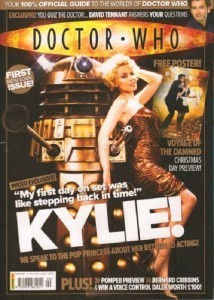 TANSY:
TANSY:
And yes, Kylie! It was such a big deal when this came out, and casting Kylie Minogue was almost a parody of extravagant casting – a sign that the show was big, bigger than we had ever imagined it would be. She even posed with a Dalek, though unlike Katy Manning, she kept her hot-pants on. But despite the evident stunt-casting, I think her performance works really well – she brings a wistful sweetness to Astrid, and I like the depth she gives to the character, which as written could have been played by someone half Kylie’s age.
David … did you REALLY not know Kylie was in this? How had you possibly remained unspoiled about that?
DAVID:
I’ve tried very hard to avoid spoilers, which has been rather difficult! Obviously there are a few things that I can’t help but know about, like that there is someone called River Song in the future and that Neil Gaiman wrote an episode, but I have managed not to pick up too many details. Imagine how tough it was sitting on two Doctor panels at Worldcon!
So, I probably heard that Kylie was in an episode at some point, but I would have just let it go in one ear and out the other, and definitely wouldn’t have remembered which episode it was exactly.
TEHANI:
I just did about my fourth rewatch of this episode, and think that this is probably the strongest acting I’ve ever seen from Kylie. Still a little cringey at times, but I think that was more about the instant Doctor-adoration than the Aussie-ness of her performance! Solid!
TANSY:
I love that in the last year you’ve gone from someone who’d never watched the show to someone who has watched some episodes FOUR times!
TEHANI:
Instant fangirl, just add Doctor! 
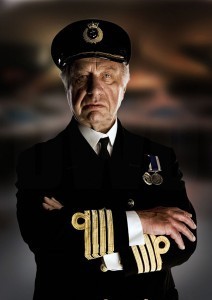 DAVID:
DAVID:
The cast in general is very strong, quite a few actors who, even if you can’t put a name on them straight away, you know that you have seen them before. Clive Swift will always have a special place in my heart and Geoffrey Palmer is excellent as the doomed Captain. And, it’s good to see that they’ve kept up up the Christmas Special tradition of a villain who relished the chance to chew up the scenery (and a few other traditions I am sure we will come to later!). George Costigan appears to channelling Doctor Evil at some point!
TANSY:
Yes there are some great parts and casting choices considering that it is basically a disaster movie with a limited time for each of the roles to shine. I love that they got in someone with Geoffrey Palmer’s track record to play what amounted to a couple of scenes, but didn’t he sell those scenes gorgeously?
TEHANI:
I adore Geoffrey Palmer! He’s a fantastic actor and it was really cool to see him in this.
Tansy, you’ll have known this of course, but I have just been surprised by the Doctor Who connections of many of the cast, listed in the Wikipedia entry for the episode:
Clive Swift and Geoffrey Palmer have had previous roles in the classic series. Swift portrayed Jobel in Revelation of the Daleks, while Palmer played Undersecretary Masters in Doctor Who and the Silurians, and an administrator in The Mutants. Jessica Martin had played Mags in The Greatest Show in the Galaxy. In addition, Bernard Cribbins played Tom Campbell in Daleks’ Invasion Earth: 2150 A.D., the second Doctor Who feature-film adaptation starring Peter Cushing as well as Arnold Korns in the audio play Horror of Glam Rock.
And of course, we’ll see more of Bernard Cribbins later (no spoilers David!).
TANSY:
I knew about Bernard Cribbins and Geoffrey Palmer (if you want to see a young Cribbins, the two Peter Cushing Dalek movies make great family viewing fare for Saturday afternoons, and the DVD release for them was super cheap)! I remember Jessica Martin as Mags too but had forgotten she was in this in the blink-and-you’ll-miss-it role of the Queen’s voice. I had no idea about Clive Swift, probably because I haven’t watched “Revelation of the Daleks” for 15 years or more – it was one of the few stories they didn’t include in the big ABC rescreening of classic stories in the three years before New Who began.
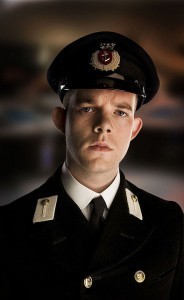 The casting choice that leaps out at me is young Russell Tovey, who is even more famous now than he was starting to be back then, thanks to Being Human and other prominent roles. This was the first thing I ever saw him in and the first time I’d even heard of him, but he is adorable as the baby-faced and steadfast midshipman Alonso Frame.
The casting choice that leaps out at me is young Russell Tovey, who is even more famous now than he was starting to be back then, thanks to Being Human and other prominent roles. This was the first thing I ever saw him in and the first time I’d even heard of him, but he is adorable as the baby-faced and steadfast midshipman Alonso Frame.
DAVID:
I thought Kylie was wonderful in this, but it seems the Doctor only has to look at someone before they want to jump on the TARDIS! Not that the Doctor can talk, his loneliness is very apparent in how eager he is to replace Martha. One can’t help but wonder how much fun it might have been had Mr Copper become the new companion, but that was never on the cards. Shame.
TANSY:
Ha yes, the Doctor totally gave Mr Copper the brush off, didn’t he? Funny how he tends to only encourage the young, hot ladies for the most part… I do like the Astrid-Doctor relationship, and the fact that she obviously has saucy designs on him (love the crack where he says she should see him in the morning and she is TOTALLY up for that), even though it is the third companion who has fancied the pants off him (thank goodness for Donna!)
But I also like how much of a story we get to Astrid, through only a few telling details. Her longing to travel and her wonder at walking the “alien” streets of London is very touching, and you get the sense that she would have been a very good companion in the classic sense. While she has nothing else in common with Ace, I was reminded of her with the set up of the waitress who ends up waiting tables no matter how exotic the location she travels to…
Oooh and another tidbit – there were huge rumours ahead of time about what Astrid’s role would be, because her name is an anagram of TARDIS. But that was a total red herring.
TEHANI:
This is what I love best about these reviews with you two – all the little tidbits (even when they were red herrings)! 
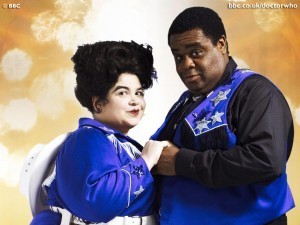 DAVID:
DAVID:
The rest of the characters are all very well realised (if quite stereotypical), from the oily rich man to the midshipman whose sense of duty shines through. I particularly loved the Van Hoffs and was devastated when they died. There is a very high body count in this episode actually! The whole secondary characters dying in noble self sacrifice is very Classic Who, seemed to happen almost every episode.
TANSY:
From what I have heard, disaster movies are actually a big TV tradition in the UK, and so this was constructed with that in mind. It’s the first time (except maybe for 1996) that Doctor Who has really felt like an action movie rather than a TV show. And of course the high body count goes along with that – bumping everyone off one by one.
I really liked the Van Hoffs too – I wince at the ‘comedy of fat’ elements that I think go too far, but it’s pretty clear that everyone who mocks them is an ass. They’re a great example of a sweet, loving couple. It’s a sign of how great their relationship is that Morvin laughs his head off when Foon confesses her terrible secret. And oh – you really feel for her when he falls, and later when she sacrifices herself in such a heroic fashion, and you know that it’s because she doesn’t want to be without him.
TEHANI:
After multiple watchings, I thought the “comedy of fat” elements were actually quite well done – like you said, anyone who mocks is obviously an ass, and the way the Van Hoffs handle the mockage is great. Just my thoughts though 
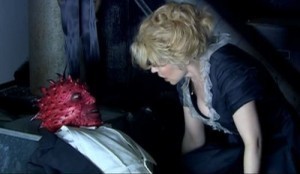 TANSY:
TANSY:
Ha yes I agree with you after this viewing but I think in the past I was wincing too much to notice – and Russell T Davies does have something of a habit of writing fat characters that are figures of fun.
Bannakaffalata was a lovely alien addition to the crew of survivors – I like how many of these characters had a comic dimension to them, balanced out with the horror and drama of what’s happening to them.
TEHANI:
Back to David’s point about the high body count: for some reason, I had it in my head that midshipman Alonso also bit the dust at the end of the episode, until I rewatched again today. There’s so many people who die, it just must have stuck that he did too!
As an aside, the Doctor’s glee at being able to say, “Allons y Alonso!” was just delightful.
TANSY:
He totally seems marked to die, doesn’t he? I had a similar experience with the movie American Graffiti, where I misremembered the ending for years and was deeply upset at the death of a character in a car crash … and then later watched it and discovered that he came out of it just fine!
The Allons y Alonso line actually really confused me the first time I heard it, I think because “Allons y” had not registered with me as a true Doctor catchphrase – he’d only used it a few times before this special, maybe only once – and I’d forgotten about it. Now of course, it makes sense! I think I was annoyed at it originally as a blatantly tacked-on catchphrase, but as with many things Whoish, familiarity and nostalgia has swept away the irritation.
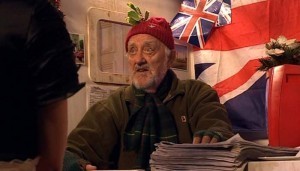 I have to say one of my favourite bits of this whole episode is the Bernard Cribbins cameo, and the whole reference back to the previous two Christmases and why everyone in London has evacuated. It’s just brilliant! I enjoy these details that show how the stories we have watched have changed the perception of the world around them in these high media days. I also like the Doctor trying to defend Christmas from Mr Copper’s slanders, only to break and admit, “What am I saying, my Christmases are always like this.”
I have to say one of my favourite bits of this whole episode is the Bernard Cribbins cameo, and the whole reference back to the previous two Christmases and why everyone in London has evacuated. It’s just brilliant! I enjoy these details that show how the stories we have watched have changed the perception of the world around them in these high media days. I also like the Doctor trying to defend Christmas from Mr Copper’s slanders, only to break and admit, “What am I saying, my Christmases are always like this.”
DAVID:
The idea that all these alien invasions have consequences has been touched upon quite a bit in New Who, from the Christmas invasions to the alien museum, and it is an idea that I like. Once things go public, it makes sense that these things would change the perceptions and worldviews of the average person. It doesn’t seem credible that they would just exist in isolation, or be so easily covered up. I’ve also liked the little nods to the idea that there would be groups that might notice the Doctor cropping up throughout history and build conspiracy theories around it, as well.
 TANSY:
TANSY:
The Christmas (disaster) special was something that we got entirely from New Who rather than Classic, and to me really sums up the RTD era as a whole – I love how quickly and easily it formed a tradition, and one which we take completely for granted. Not sure that we really needed the running joke about pretendy snow, though – yes they always make it snow in Christmas movies, and yes it never snows in London at Christmas but I seem to recall around about the time this special was released that they DID have a massive cold snap, and London had snow at Christmas. Time to retire the joke, Russell T…
=======
Watching New Who – in conversation with David McDonald, Tansy Rayner Roberts and Tehani Wessely
David is coming to New Who for the first time, having loved Classic Who as a kid. Tehani is a recent convert, and ploughed through Seasons 1 to 6 (so far) in just a few weeks after becoming addicted thanks to Matt Smith – she’s rewatching to keep up with David! Tansy is the expert in the team, with a history in Doctor Who fandom that goes WAY back, and a passion for Doctor Who that inspires us all (plus a seven-year-old daughter who is finding her own Doctors for the first time). We’re going to work our way through New Who, using season openers and closers, and Hugo shortlisted episodes, as our blogging points. Just for fun! We have already talked about:
“Rose”, S01E01
“Dalek”, S01E06
“Father’s Day, S01E08
“The Empty Child/The Doctor Dances”, S01E09/10
“Bad Wolf/The Parting of the Ways”, S01E12/13
Season One Report Card – David, Tansy, Tehani
“The Christmas Invasion,” 2005 Christmas special
“New Earth”, S02E01
“School Reunion,” S02E03
“The Girl in the Fireplace”, S02E04
“Rise of the Cybermen/Age of Steel”, S02E05/06
Army of Ghosts/Doomsday, S02E12/13
Season Two Report Cards: David, Tehani, Tansy
“The Runaway Bride”, 2006 Christmas Special
“Smith and Jones”, S03E01
The Shakespeare Code & Gridlock, S0302-03
Human Nature/The Family of Blood S0308-09
Blink S0310
Utopia / The Sound of Drums / Last of the Timelords S0311-13
September 10, 2012
Where the Wonder Women Are: #20 Supergirl
 My recent immersion in the world of superheroes started in early 2010, with Supergirl. Raeli had taken an interest in the character, based almost entirely on the image on a drinking glass (like Superman, only a girl, what else is there to know?) and I started hunting for some kind of media property that I could stand to share with my 5 year old daughter. One thing I learned very quickly from the feminist comics blogs I followed was that it wasn’t going to be the comic, which featured some pretty skeevy artwork (yep, let’s all peer up the teenage girl’s tiny skirt, shall we and OH apparently female superheroes don’t need all their ribs) and was squarely aimed at men, not young and impressionable girls.
My recent immersion in the world of superheroes started in early 2010, with Supergirl. Raeli had taken an interest in the character, based almost entirely on the image on a drinking glass (like Superman, only a girl, what else is there to know?) and I started hunting for some kind of media property that I could stand to share with my 5 year old daughter. One thing I learned very quickly from the feminist comics blogs I followed was that it wasn’t going to be the comic, which featured some pretty skeevy artwork (yep, let’s all peer up the teenage girl’s tiny skirt, shall we and OH apparently female superheroes don’t need all their ribs) and was squarely aimed at men, not young and impressionable girls.
So where else? I had a vague memory that the 80’s Supergirl movie had been fairly dreadful but I had loved it, so there was always that. At a pinch.
Finally I decided upon Justice League Unlimited. I’d enjoyed the earlier Justice League cartoon, though not enough to actually buy the DVDs. But it looked like they had a cute, interesting Supergirl character, and so I gave it a punt. Only to discover that in fact JLU was full of all kinds of amazing and well-constructed female characters, and while the Supergirl was indeed spunky and super cute, she didn’t hold a candle to Black Canary, Huntress and Wonder Woman.
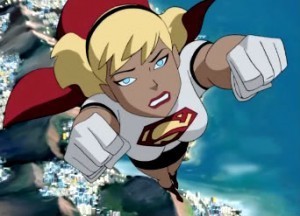 Luckily for me, Raeli embraced female superheroes as a whole, and we started out on a long and crazy journey of discovery together. It’s been super fun. And the massive pile of JLU lady action figures I acquired from eBay didn’t hurt at all.
Luckily for me, Raeli embraced female superheroes as a whole, and we started out on a long and crazy journey of discovery together. It’s been super fun. And the massive pile of JLU lady action figures I acquired from eBay didn’t hurt at all.
This week, while doing a bit of covert pre-Christmas detective work (as you do) I asked both Raeli (now nearly 8!) and her recently 3-year-old sister Jem which they preferred, Batgirl or Supergirl. To be frank, I assumed that at least ONE of them would pick Batgirl. They’re both thoroughly Bat-obsessed, after all. Raeli has just received the LEGO Batcave she saved her pocket money up for six months, and Jem regularly dresses up as Batman and insists on being called that.
But no, they both immediately picked Supergirl. Which not only put a serious spanner in my Christmas present buying plans, it made me think. What is it about this character that makes her so compelling that she gets to be the best, the favourite, of little girls everywhere, based on a variety of wildly differing properties?
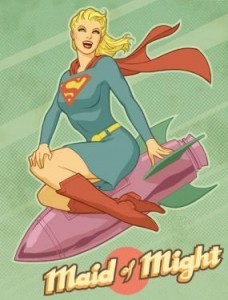 Like Wonder Woman, Supergirl has survived as an iconic female superhero despite all kinds of bizarre and outlandish things that have been done to her story and character over the years. I’m pretty sure she’s been killed off and rebooted more often than Wonder Woman.
Like Wonder Woman, Supergirl has survived as an iconic female superhero despite all kinds of bizarre and outlandish things that have been done to her story and character over the years. I’m pretty sure she’s been killed off and rebooted more often than Wonder Woman.
At its heart, Supergirl/Kara Zor El’s story is simple. She’s Superman’s younger cousin, his spin off, his girl equivalent. She has all the same powers he does, she comes from Krypton, basically it’s all the same but she doesn’t get to snog Lois Lane (or indeed Wonder Woman) and she wears a skirt.
Raeli has come across various versions of the character since she’s been reading comics, and I’ll admit that the world is a happier place for junior Supergirl fans than it was a few years ago (or maybe I have a better idea where to look).
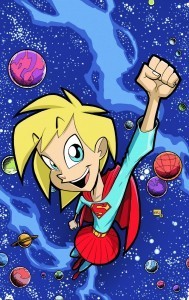 There’s Supergirl: Cosmic Adventures in the 8th Grade, a fun and peppy modern comic that gives Kara crazy eyes and a not-quite-manga sensibility. There’s the sadly too-few Super Best Friends Forever minisodes from DC Shorts, which portrays her as a delightfully hefty gal who relishes her strength and lives to kick butt. There’s the fun and baby-faced version from kid favourite comic Tiny Titans who remains one of the only characters who got to cross over into the next project by the same creators: Superman Family.
There’s Supergirl: Cosmic Adventures in the 8th Grade, a fun and peppy modern comic that gives Kara crazy eyes and a not-quite-manga sensibility. There’s the sadly too-few Super Best Friends Forever minisodes from DC Shorts, which portrays her as a delightfully hefty gal who relishes her strength and lives to kick butt. There’s the fun and baby-faced version from kid favourite comic Tiny Titans who remains one of the only characters who got to cross over into the next project by the same creators: Superman Family.
There’s even a Polly Pocket.
In recent years, the explosion of popularity of superheroes has meant that even girls sometimes get tie in t-shirts, and the characters who tend to show up on those glittery pink tees are Supergirl, Batgirl, Wonder Woman.
As with the drinking glass effect, Supergirl is a character that young girls in particular are drawn to. The combination of super heroics and blonde hair are apparently irresistible. Like, imagine if Barbie actually did stuff!
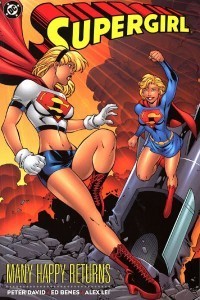 I still haven’t read many modern Supergirl comics. I tried with the New 52 but I was so outraged that her costume was explained as a Kryptonian uniform signifying graduation honours (you honour your graduates by making them wear skirts that tiny, what is this, Starfleet?) that I couldn’t follow through. And then there’s the inhumanly skinny waist which feels problematic to me in a character with so much pull among teenage and pre-teen girls. (most superheroines and indeed superheroes have unrealistic body types but when you’re depicting teenagers with waists that would require even Buffy to have a few organs removed, that’s a red flag)
I still haven’t read many modern Supergirl comics. I tried with the New 52 but I was so outraged that her costume was explained as a Kryptonian uniform signifying graduation honours (you honour your graduates by making them wear skirts that tiny, what is this, Starfleet?) that I couldn’t follow through. And then there’s the inhumanly skinny waist which feels problematic to me in a character with so much pull among teenage and pre-teen girls. (most superheroines and indeed superheroes have unrealistic body types but when you’re depicting teenagers with waists that would require even Buffy to have a few organs removed, that’s a red flag)
Classic Supergirl, though. Ahhh, classic Supergirl. I’m a fan. And indeed, with all the reading I’ve been doing, I’ve come to the conclusion that even the modern tiny-skirted Supergirl can be quite awesome, when she’s written for example as the awesome best friend of Stephanie Brown’s Batgirl.
So Supergirl. She’s blonde, she’s less experienced than Superman (it makes him feel manly), and she’s a good friend. But what exactly does she do?
Let’s go back to the beginning and find out.
The original Supergirl was launched in 1959 and continued until her death in 1986, one of the major events of the Crisis on Infinite Earths. The cover image of Superman holding her body and grieving is probably one of the most parodied, copied and remembered comics cover image of all time.
Supergirl was a sweetie. She appeared in Superman and Action Comics at first, then later had her own title Adventure Comics, and appeared in Superman Family. She was created by Otto Binder who had also created Mary Marvel, the sweet teen counterpart to DC’s Captain Marvel, and Miss America, the girl version of Marvel’s Captain America.
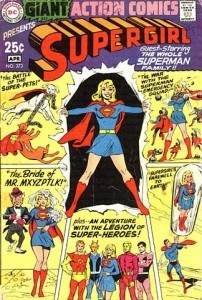 Kara Zor-El was the last survivor of Argo City, which fragmented off from Krypton when it was destroyed, and drifted through space for some time. This is one of many over-complex plot complications introduced over the years to ensure that Kara is always much younger than her cousin Kal-El, in every iteration of her character, despite the fact that he was a baby when sent away from the exploding Krypton (in Cosmic Adventures in the 8th Grade, for instance, his rocket simply travels at a different speed to hers, and she ages slower in stasis).
Kara Zor-El was the last survivor of Argo City, which fragmented off from Krypton when it was destroyed, and drifted through space for some time. This is one of many over-complex plot complications introduced over the years to ensure that Kara is always much younger than her cousin Kal-El, in every iteration of her character, despite the fact that he was a baby when sent away from the exploding Krypton (in Cosmic Adventures in the 8th Grade, for instance, his rocket simply travels at a different speed to hers, and she ages slower in stasis).
Once she arrives on Earth, Kara attends high school (later college) as brunette Linda Lee Danvers, putting on a wig to hide her natural blonde locks. Comics work that way. Men just have to put on a pair of glasses as a disguise; women have to change their hair colour.
Kara Zor-El had many adventures over the thirty five years or so that she was around as a character (appearing in over 750 stories during this period, according to Wikipedia), and after graduating went on to be a counsellor, news reporter and soap actress. She had a pet cat Streaky (who has a substantial role in Tiny Titans! My godson decided this year after their family lost their cat that they really needed a Streaky, though he wasn’t sure how to make sure that they got one with superpowers) and Comet the Superhorse. She also regularly teamed up with Barbara Gordon’s Batgirl, her best friend. Her family turned up at one point and took up residence in the Bottle City of Kandor, which is basically a Kryptonian city shrunk down and kept in a bottle.
The Silver Age version of Supergirl is mostly characterised by her student identity and her life with adoptive family the Danvers. The Bronze Age (1970’s) version allowed her a more adult identity and also heralded her first solo title actually named “Supergirl,” something Batgirl didn’t get until the 1990’s. An alternative version of Supergirl, Power Girl, appeared in comics set in Earth 2.
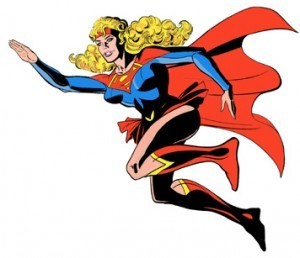 1980’s Supergirl on the other hand stands out because of her extraordinary permed hair, red hair band and occasional resemblance to Olivia Newton John. In 1984, a live action film starring Helen Slater (with Faye Dunaway as the villain) appeared as a tie-in to the Superman movies of the time. It appeared a year after Superman III, and while both films were critically panned, Superman continued as a franchise and Supergirl did not. The Supergirl title had been cancelled only months before the movie was released. And of course, it was the first of a long line of “examples” why superhero movies starring women aren’t financially viable, regardless of whether they are set up to succeed in the first place.
1980’s Supergirl on the other hand stands out because of her extraordinary permed hair, red hair band and occasional resemblance to Olivia Newton John. In 1984, a live action film starring Helen Slater (with Faye Dunaway as the villain) appeared as a tie-in to the Superman movies of the time. It appeared a year after Superman III, and while both films were critically panned, Superman continued as a franchise and Supergirl did not. The Supergirl title had been cancelled only months before the movie was released. And of course, it was the first of a long line of “examples” why superhero movies starring women aren’t financially viable, regardless of whether they are set up to succeed in the first place.
The comic book adaption of the movie is one of the first comics I ever read, and I recall loving it while still being aware that it wasn’t actually that good. This is the power of Supergirl: as a character, she transcends crappy writing.
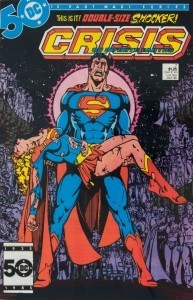 Supergirl’s death in the comics was one of the central events of the 1986 Crisis event, and as with many other characters who died in that event (though not Barry Allen’s Flash, the other most high profile sacrifice in that storyline) everyone’s memory of her was wiped out, as if she had never existed.
Supergirl’s death in the comics was one of the central events of the 1986 Crisis event, and as with many other characters who died in that event (though not Barry Allen’s Flash, the other most high profile sacrifice in that storyline) everyone’s memory of her was wiped out, as if she had never existed.
Earth 2’s Power Girl remained in the new reality (after the various Earths of the multiverse merged), believing herself to be Superman’s cousin, though she later discovered she was wrong, then so wrong, then a bit right, then totally right, and possibly crazy. She’ll get her own post later.
Behind the scenes, the head men at DC wanted Superman to be unique, and felt that Kara’s presence diminished him and the epicness of his story. Which makes me want to go back in time and kick them.
Two years later, a new Supergirl debuted in the DC Universe. Matrix, created by John Byrne (who has a pretty good history of being awesome about female superheroes) came from an alternate reality where Lex Luthor was a good guy and Superman had died young. Luthor, who spent a lot of time gazing through realities stalker-style at the Earth 1 Superman when he wasn’t sadly mourning his lost love, Alternate Lana Lang, created a pretend shapeshifting lady who merged qualities from both of them.
Matrix promptly put on a Supergirl costume, made her hair blonde, and kicked butt. Sadly the world was destroyed (through no fault of her own!) and Superman ended up rescuing only Matrix, bringing her through to his reality. He shipped her off to his parents (as Superman usually does with his cousin, the funniest example being one of the Super Best Friends Forever cartoon shorts) who did their best to raise Matrix as their daughter with the same kind of old home values they had invested in Clark.
Sadly it didn’t work out that well and Matrix (or Mae) lurched back and forth erratically, caught between her desire to be a superhero and her natural tendency to turn into shapeshifting goo or to flip out and lose hold on reality. She then found a way to freak out her entire adoptive family, by becoming the live-in girlfriend of Lex Luthor II.
The large, red-headed Australian son of the original evil Lex Luthor, Lex II was in fact the original Lex in the body of a rugged Aussie bloke. No one knew this, however, so frankly their suspicions were based on prejudice. I have to say, coming across “Lex II” and Matrix Supergirl for the first time ever in the Death of Superman storyline came as a shock to me, being familiar mostly with old school Kara and Luthor. What the WHAT? Supergirl is a blob of goo and she’s shacked up with LEX LUTHOR?
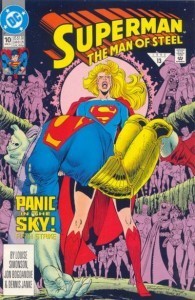 After being showcased to great effect during Panic in the Sky, a storyline that emphasised how the relationship between Matrix and Lex had caused a rift between her and Clark, Mae and Lex later came into their own in the wake of the Death of Superman storyline, as a power couple striving to rebuild Metropolis and provide stability after the world’s great loss. However, Lex’s possessiveness and manipulative nature became more obvious, and Mae often had to slip away from him in order to help Lois and the city.
After being showcased to great effect during Panic in the Sky, a storyline that emphasised how the relationship between Matrix and Lex had caused a rift between her and Clark, Mae and Lex later came into their own in the wake of the Death of Superman storyline, as a power couple striving to rebuild Metropolis and provide stability after the world’s great loss. However, Lex’s possessiveness and manipulative nature became more obvious, and Mae often had to slip away from him in order to help Lois and the city.
When she discovered that Lex had been secretly cloning her… well let’s just say the break up was messy. Matrix was left drifting, with no real sense of who she was, or whether she was really even a person. She then merged with a dying woman called Linda Danvers, became an angel, and finally disappeared from the DC Universe just in time for the “original” Supergirl (or at least the original Supergirl concept) to return.
The new old Supergirl, Kara Zor-El, had reappeared briefly in continuity before the Matrix-Linda Danvers version was written out, in the Many Happy Returns storyline by Peter David. It had long been felt that, as with many characters, the post-Crisis continuity was too damn complicated, and the simplest version of the character’s backstory was of course the original one. (you think?)
Stuck in a Kryptonian asteroid crashing Armageddon-style to Earth, Kara Zor-El arrived (again) with a bang in the Superman/Batman title in 2004, and took on the Supergirl identity. After a few years, even made an artistic choice to give her biker shorts instead of panties under her short skirt, this seeming more “respectful.” While being chronologically older than Superman, she was of course physically a young teenage girl (as always) and thus able to be patronised by him at any opportunity.
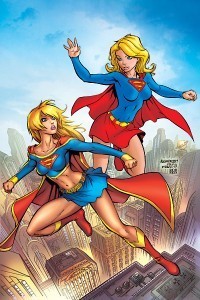 Trained at first by Wonder Woman and the Amazons, Supergirl’s journey to find her own heroic path has continued in her own comic for many years now. She was transported to the future for a while, taking up membership of the Legion of Super-Heroes, and has also fought under the identity of Flamebird in the bottle city of Kandor. A variety of different creators meant a whole bunch of different creative directions through the 2000’s, and many of them couldn’t resist throwing in new “true” origin stories for her, which muddied the waters.
Trained at first by Wonder Woman and the Amazons, Supergirl’s journey to find her own heroic path has continued in her own comic for many years now. She was transported to the future for a while, taking up membership of the Legion of Super-Heroes, and has also fought under the identity of Flamebird in the bottle city of Kandor. A variety of different creators meant a whole bunch of different creative directions through the 2000’s, and many of them couldn’t resist throwing in new “true” origin stories for her, which muddied the waters.
Kara’s lack of experience with humanity and the loss of any solid family base for her meant that she had far more trouble fitting in than her Silver/Bronze Age counterpart had. She eventually finds a secret identity for herself, posing as Lana Lang’s niece Linda for some time, though she eventually broke her connection from Lana after a traumatic storyline involving insect queens.
My entry point to this version of Supergirl comes from my reading of the Stephanie Brown Batgirl series, in which Kara/Linda turns up in one glorious issue for a Girl’s Night Out which showcases their friendship beautifully and reveals Kara as a fun loving superhero without the kind of heavy baggage her character had been weighed down with in her own book.
The New 52 rebooted Supergirl yet again, came up with another reason for her to crash to Earth many years after Clark Kent and yet be way younger than him, and made her short skirt even shorter. The title didn’t interest me much, but then I’m a 30+ woman who’s all cynical. Supergirl’s main DC title shouldn’t be written for me any more than it should be written for blokes. It should be written for my daughters.
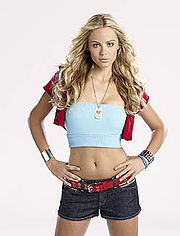 Kara Zor-El was a semi-regular character in season 7 of the live action TV series Smallville, played by Laura Vandervoort and Adrienne Palicki. The classic elements of her storyline – being young and confused and trying to fit in with humans despite having super strength, and not having the same rock solid childhood advantage of Clark Kent – were expressed through the show’s seventh season, and then they shut her up in the Phantom Zone to get rid of her. She only returned in occasional guest spots after that.
Kara Zor-El was a semi-regular character in season 7 of the live action TV series Smallville, played by Laura Vandervoort and Adrienne Palicki. The classic elements of her storyline – being young and confused and trying to fit in with humans despite having super strength, and not having the same rock solid childhood advantage of Clark Kent – were expressed through the show’s seventh season, and then they shut her up in the Phantom Zone to get rid of her. She only returned in occasional guest spots after that.
The animated Supergirl – the point at which I came in – is based very much on the modern version of the character, including her fairly distant if fond relationship with Superman, and her inability to properly integrate with humanity. After appearing in other animated films/series, she found her destiny in the Justice League Unlimited series, falling in love with Brainiac 5 and leaving the present day to join the Legion of Super-Heroes in the future. Yep, she might be cute but there’s a REASON I started encouraging my daughters to appreciate Huntress’ awesomeness instead…
 Animated Supergirl, who is designed as a teeny pocket rocket compared even to the other small women on the show, is voiced mostly by Nicholle Tom, both in the animated adventures of Superman and JLU, though a one-off movie Superman/Batman: Apocalypse has her voiced by Summer Glau. This movie, based closely on the Superman/Batman comic storyline that introduced New Old Supergirl, had her name and image removed from the packaging in response to poor sales of the Wonder Woman animated movie. Which is why it took me two years to realise there was in fact an animated Supergirl movie out there. Sigh.
Animated Supergirl, who is designed as a teeny pocket rocket compared even to the other small women on the show, is voiced mostly by Nicholle Tom, both in the animated adventures of Superman and JLU, though a one-off movie Superman/Batman: Apocalypse has her voiced by Summer Glau. This movie, based closely on the Superman/Batman comic storyline that introduced New Old Supergirl, had her name and image removed from the packaging in response to poor sales of the Wonder Woman animated movie. Which is why it took me two years to realise there was in fact an animated Supergirl movie out there. Sigh.
There’s a solid story here. For all my discomfort about Supergirl being written out of JLU by falling in love, I think that this animated version of the character captured most of the key elements of the character. Supergirl can be cute and blonde but she also should be confused and angry. She never gets the stable childhood that Clark Kent received, and so the balance of her alien/superhero self and “real life” should be harder, and it’s okay for her to be frustrated about it.
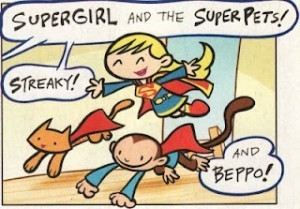 Tiny Titans, Supergirl: Cosmic Adventures in the 8th Grade and the brief appearances of the stompy Supergirl in Super Best Friends Forever get it very right, I think, while approaching the character in very different ways. I also loved the recent appearance of Supergirl in Ame-Comi Girls, and noted how differently the story works when Power Girl is put in Superman’s place (and indeed in Clark Kent’s place, with his childhood and loving parents) and then Supergirl crashes in her asteroid… I’m excited to see where this story goes, because while Supergirl is once more the “older” cousin who is now younger thanks to spacey-wacey time dilation, having two women at the centre of that story finally offers a new twist.
Tiny Titans, Supergirl: Cosmic Adventures in the 8th Grade and the brief appearances of the stompy Supergirl in Super Best Friends Forever get it very right, I think, while approaching the character in very different ways. I also loved the recent appearance of Supergirl in Ame-Comi Girls, and noted how differently the story works when Power Girl is put in Superman’s place (and indeed in Clark Kent’s place, with his childhood and loving parents) and then Supergirl crashes in her asteroid… I’m excited to see where this story goes, because while Supergirl is once more the “older” cousin who is now younger thanks to spacey-wacey time dilation, having two women at the centre of that story finally offers a new twist.
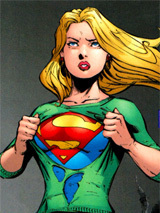 Kara Zor-El is a great character, with huge potential and recognisability to young girls. If written and presented well, she could easily be the new Buffy or Veronica Mars of a generation. But creators need to stop thinking of her as a property that must appeal to male comics readers. Like Batgirl, she was designed to appeal to young women back in the day, and she still has the power to do that, given half a chance.
Kara Zor-El is a great character, with huge potential and recognisability to young girls. If written and presented well, she could easily be the new Buffy or Veronica Mars of a generation. But creators need to stop thinking of her as a property that must appeal to male comics readers. Like Batgirl, she was designed to appeal to young women back in the day, and she still has the power to do that, given half a chance.
Girls, especially young girls, love Supergirl. They will buy dolls based on her and t-shirts with her face on them, even if they’ve never read a comic or seen her on TV. They get her. So while I mourn the loss of Tiny Titans, I am delighted that the new project by the same creators, Superman Family, provides a home for a slightly older version of the Tiny Titans Supergirl. There will be more fun, lighthearted adventures for my girls to enjoy, without me having to show them the ‘adult’ Supergirl comic.
They don’t want to see up her skirt. They just want to play with her.
Where the Wonder Women Are:
0: Introduction
1: Black Canary
2: Rogue
3: Hawkgirl/Hawkwoman
4: Black Widow
5: Wonder Girl
6: Captain Marvel
7: Vixen
8: Abigail Brand.
9. Jubilee
10. Batwoman
11. Catwoman
12. Huntress
13. Robin
14. Batgirl
15. Jean Grey
16. Ice
17. Emma Frost
18. Fire
19. Lady Sif

